ACCT20075: Ethical Audit Practices and Financial Analysis of Summerset
VerifiedAdded on 2023/06/07
|14
|3110
|201
Report
AI Summary
This report provides a comprehensive audit and ethical review of Summerset Group Holdings Limited, focusing on the 2017 financial year. It begins by determining the materiality and scope of the audit, calculating materiality based on total assets. The report reviews disclosures in the annual rep...
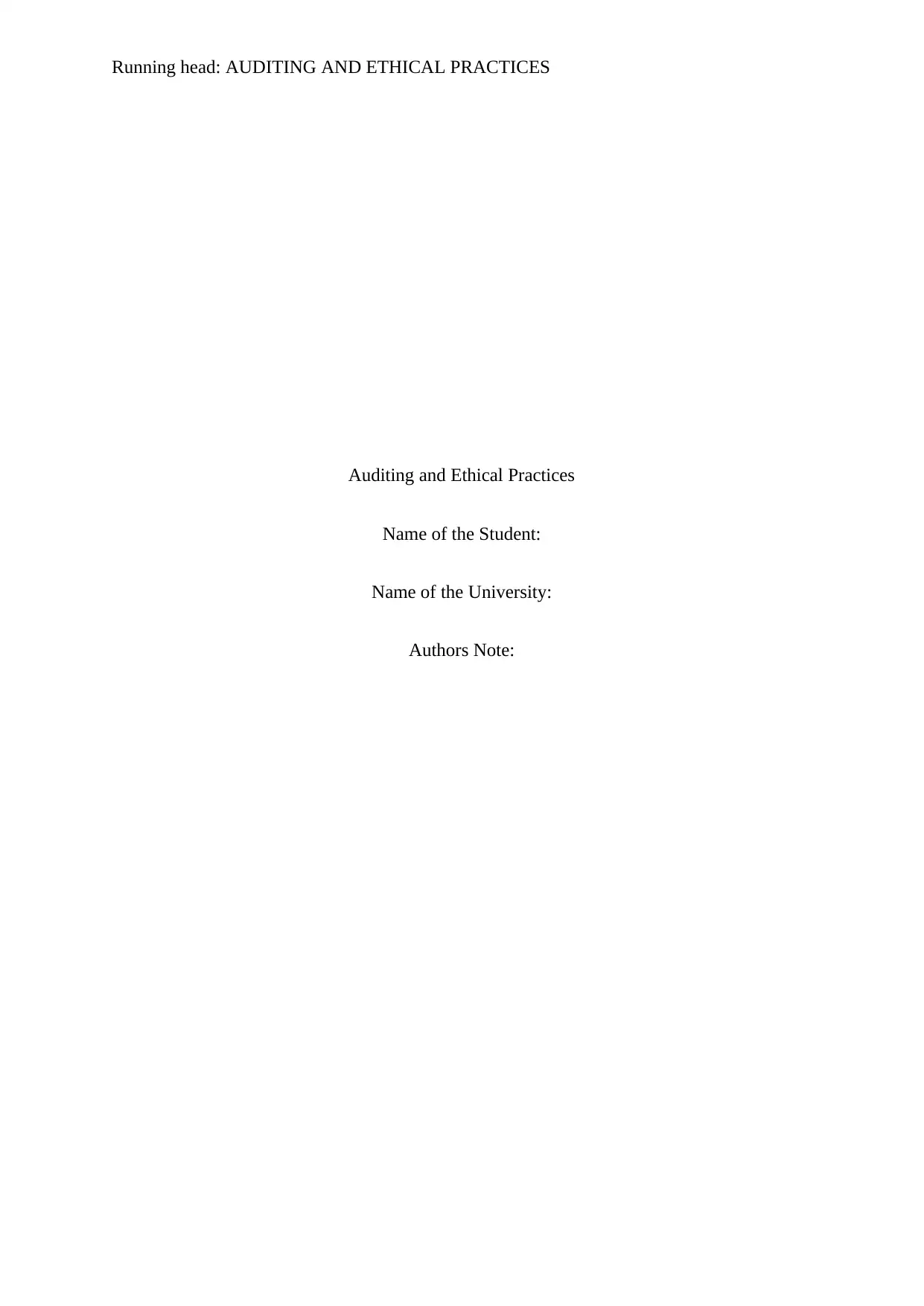
Running head: AUDITING AND ETHICAL PRACTICES
Auditing and Ethical Practices
Name of the Student:
Name of the University:
Authors Note:
Auditing and Ethical Practices
Name of the Student:
Name of the University:
Authors Note:
Paraphrase This Document
Need a fresh take? Get an instant paraphrase of this document with our AI Paraphraser
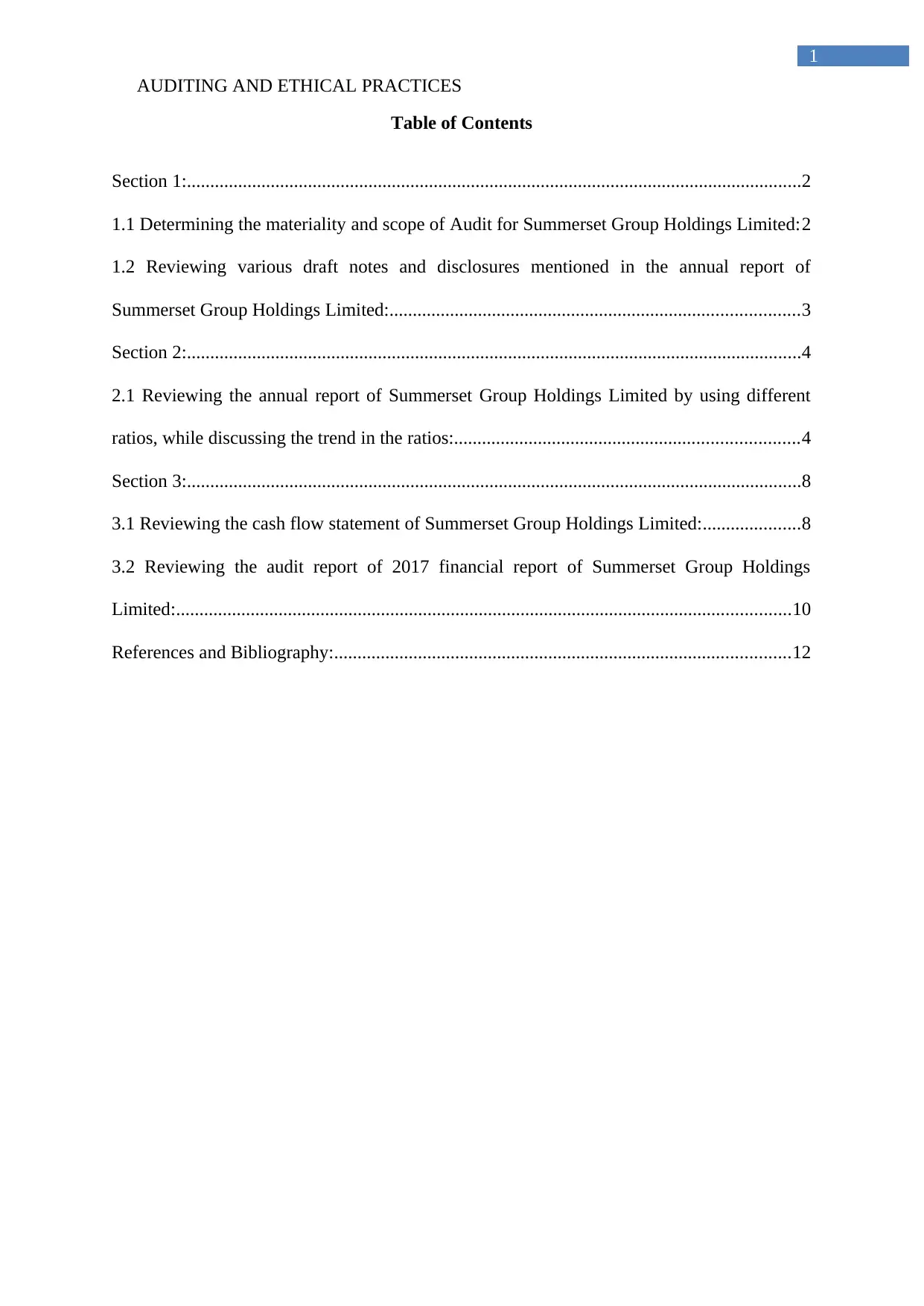
AUDITING AND ETHICAL PRACTICES
1
Table of Contents
Section 1:....................................................................................................................................2
1.1 Determining the materiality and scope of Audit for Summerset Group Holdings Limited:2
1.2 Reviewing various draft notes and disclosures mentioned in the annual report of
Summerset Group Holdings Limited:........................................................................................3
Section 2:....................................................................................................................................4
2.1 Reviewing the annual report of Summerset Group Holdings Limited by using different
ratios, while discussing the trend in the ratios:..........................................................................4
Section 3:....................................................................................................................................8
3.1 Reviewing the cash flow statement of Summerset Group Holdings Limited:.....................8
3.2 Reviewing the audit report of 2017 financial report of Summerset Group Holdings
Limited:....................................................................................................................................10
References and Bibliography:..................................................................................................12
1
Table of Contents
Section 1:....................................................................................................................................2
1.1 Determining the materiality and scope of Audit for Summerset Group Holdings Limited:2
1.2 Reviewing various draft notes and disclosures mentioned in the annual report of
Summerset Group Holdings Limited:........................................................................................3
Section 2:....................................................................................................................................4
2.1 Reviewing the annual report of Summerset Group Holdings Limited by using different
ratios, while discussing the trend in the ratios:..........................................................................4
Section 3:....................................................................................................................................8
3.1 Reviewing the cash flow statement of Summerset Group Holdings Limited:.....................8
3.2 Reviewing the audit report of 2017 financial report of Summerset Group Holdings
Limited:....................................................................................................................................10
References and Bibliography:..................................................................................................12
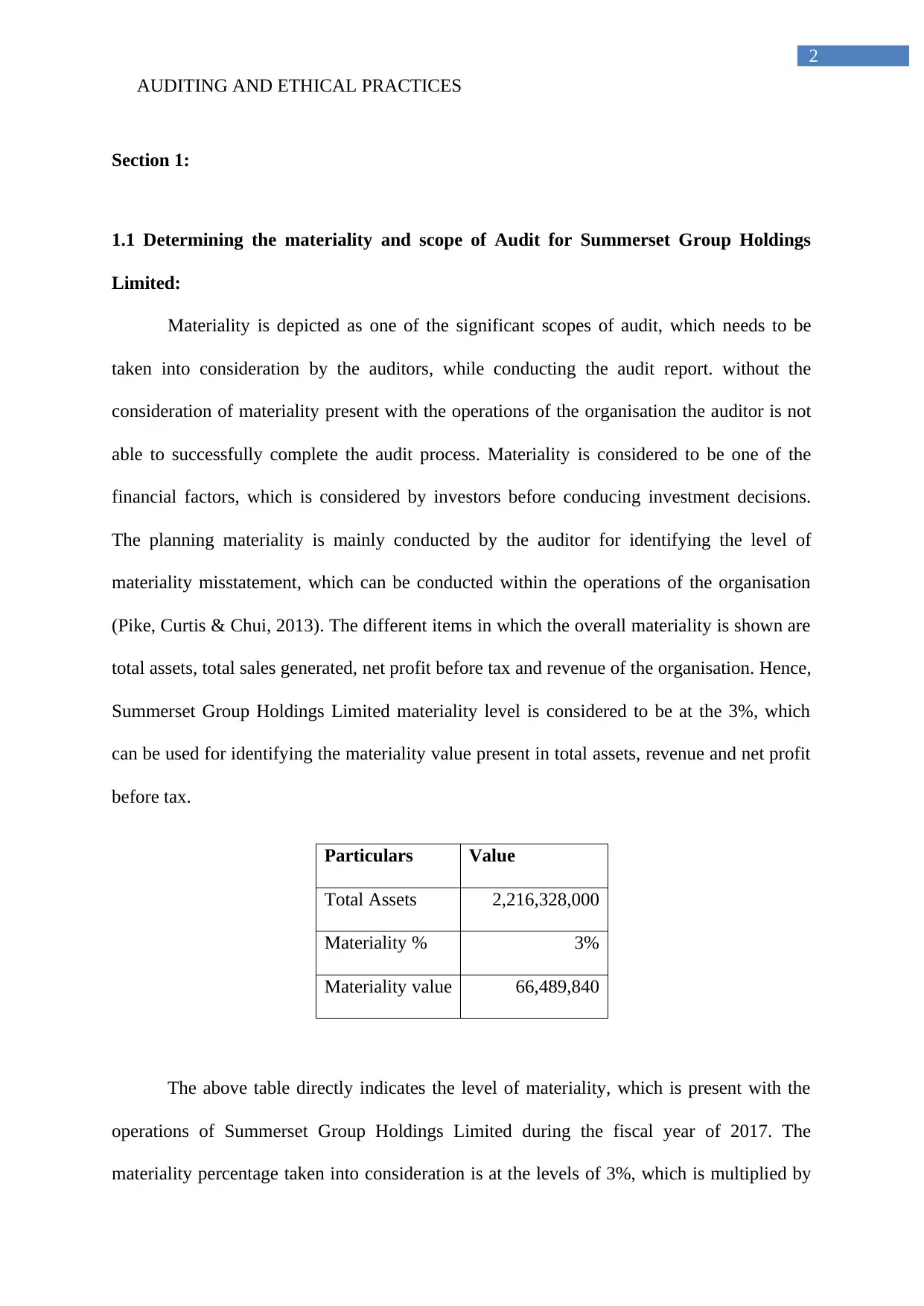
AUDITING AND ETHICAL PRACTICES
2
Section 1:
1.1 Determining the materiality and scope of Audit for Summerset Group Holdings
Limited:
Materiality is depicted as one of the significant scopes of audit, which needs to be
taken into consideration by the auditors, while conducting the audit report. without the
consideration of materiality present with the operations of the organisation the auditor is not
able to successfully complete the audit process. Materiality is considered to be one of the
financial factors, which is considered by investors before conducing investment decisions.
The planning materiality is mainly conducted by the auditor for identifying the level of
materiality misstatement, which can be conducted within the operations of the organisation
(Pike, Curtis & Chui, 2013). The different items in which the overall materiality is shown are
total assets, total sales generated, net profit before tax and revenue of the organisation. Hence,
Summerset Group Holdings Limited materiality level is considered to be at the 3%, which
can be used for identifying the materiality value present in total assets, revenue and net profit
before tax.
Particulars Value
Total Assets 2,216,328,000
Materiality % 3%
Materiality value 66,489,840
The above table directly indicates the level of materiality, which is present with the
operations of Summerset Group Holdings Limited during the fiscal year of 2017. The
materiality percentage taken into consideration is at the levels of 3%, which is multiplied by
2
Section 1:
1.1 Determining the materiality and scope of Audit for Summerset Group Holdings
Limited:
Materiality is depicted as one of the significant scopes of audit, which needs to be
taken into consideration by the auditors, while conducting the audit report. without the
consideration of materiality present with the operations of the organisation the auditor is not
able to successfully complete the audit process. Materiality is considered to be one of the
financial factors, which is considered by investors before conducing investment decisions.
The planning materiality is mainly conducted by the auditor for identifying the level of
materiality misstatement, which can be conducted within the operations of the organisation
(Pike, Curtis & Chui, 2013). The different items in which the overall materiality is shown are
total assets, total sales generated, net profit before tax and revenue of the organisation. Hence,
Summerset Group Holdings Limited materiality level is considered to be at the 3%, which
can be used for identifying the materiality value present in total assets, revenue and net profit
before tax.
Particulars Value
Total Assets 2,216,328,000
Materiality % 3%
Materiality value 66,489,840
The above table directly indicates the level of materiality, which is present with the
operations of Summerset Group Holdings Limited during the fiscal year of 2017. The
materiality percentage taken into consideration is at the levels of 3%, which is multiplied by
⊘ This is a preview!⊘
Do you want full access?
Subscribe today to unlock all pages.

Trusted by 1+ million students worldwide
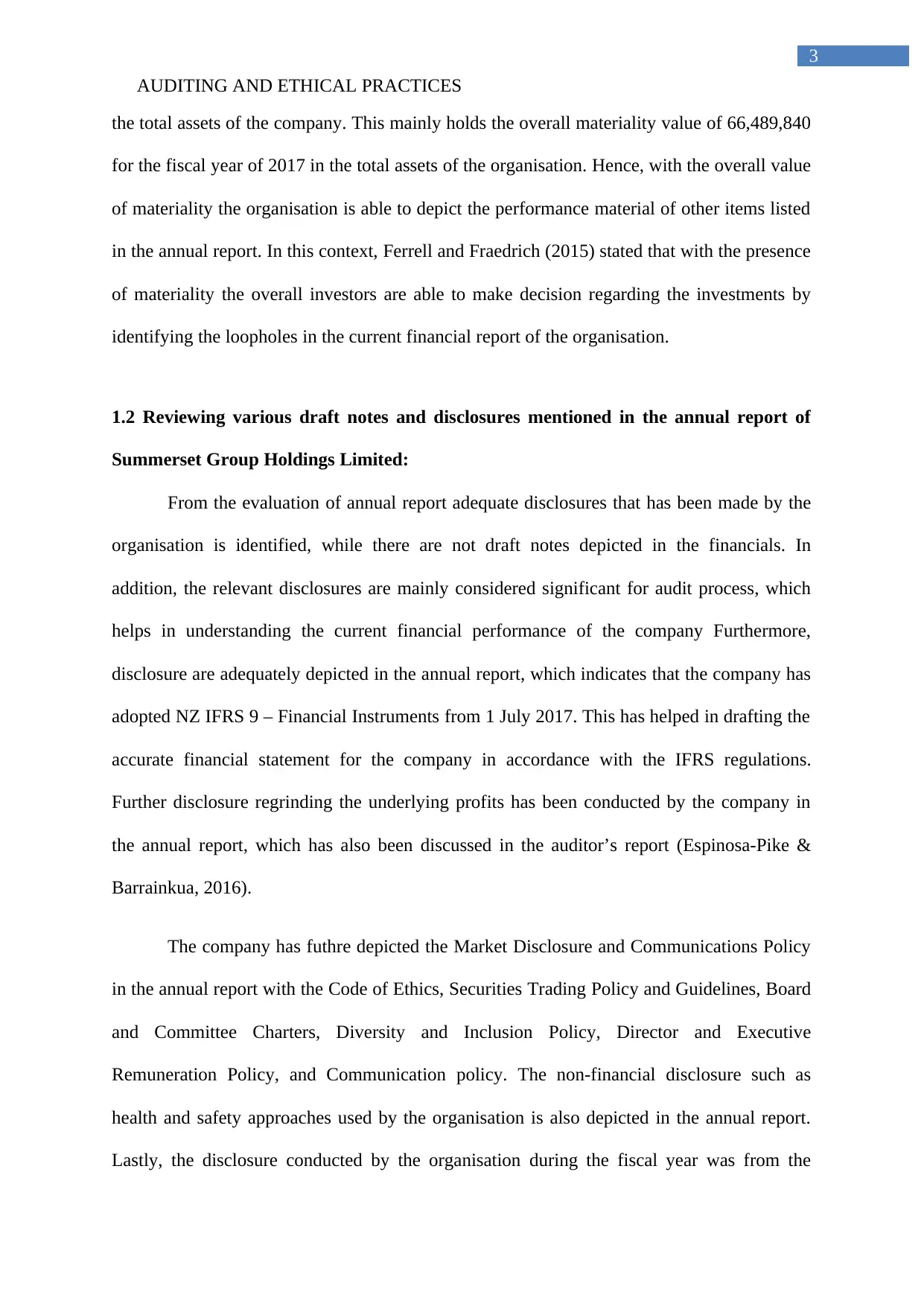
AUDITING AND ETHICAL PRACTICES
3
the total assets of the company. This mainly holds the overall materiality value of 66,489,840
for the fiscal year of 2017 in the total assets of the organisation. Hence, with the overall value
of materiality the organisation is able to depict the performance material of other items listed
in the annual report. In this context, Ferrell and Fraedrich (2015) stated that with the presence
of materiality the overall investors are able to make decision regarding the investments by
identifying the loopholes in the current financial report of the organisation.
1.2 Reviewing various draft notes and disclosures mentioned in the annual report of
Summerset Group Holdings Limited:
From the evaluation of annual report adequate disclosures that has been made by the
organisation is identified, while there are not draft notes depicted in the financials. In
addition, the relevant disclosures are mainly considered significant for audit process, which
helps in understanding the current financial performance of the company Furthermore,
disclosure are adequately depicted in the annual report, which indicates that the company has
adopted NZ IFRS 9 – Financial Instruments from 1 July 2017. This has helped in drafting the
accurate financial statement for the company in accordance with the IFRS regulations.
Further disclosure regrinding the underlying profits has been conducted by the company in
the annual report, which has also been discussed in the auditor’s report (Espinosa-Pike &
Barrainkua, 2016).
The company has futhre depicted the Market Disclosure and Communications Policy
in the annual report with the Code of Ethics, Securities Trading Policy and Guidelines, Board
and Committee Charters, Diversity and Inclusion Policy, Director and Executive
Remuneration Policy, and Communication policy. The non-financial disclosure such as
health and safety approaches used by the organisation is also depicted in the annual report.
Lastly, the disclosure conducted by the organisation during the fiscal year was from the
3
the total assets of the company. This mainly holds the overall materiality value of 66,489,840
for the fiscal year of 2017 in the total assets of the organisation. Hence, with the overall value
of materiality the organisation is able to depict the performance material of other items listed
in the annual report. In this context, Ferrell and Fraedrich (2015) stated that with the presence
of materiality the overall investors are able to make decision regarding the investments by
identifying the loopholes in the current financial report of the organisation.
1.2 Reviewing various draft notes and disclosures mentioned in the annual report of
Summerset Group Holdings Limited:
From the evaluation of annual report adequate disclosures that has been made by the
organisation is identified, while there are not draft notes depicted in the financials. In
addition, the relevant disclosures are mainly considered significant for audit process, which
helps in understanding the current financial performance of the company Furthermore,
disclosure are adequately depicted in the annual report, which indicates that the company has
adopted NZ IFRS 9 – Financial Instruments from 1 July 2017. This has helped in drafting the
accurate financial statement for the company in accordance with the IFRS regulations.
Further disclosure regrinding the underlying profits has been conducted by the company in
the annual report, which has also been discussed in the auditor’s report (Espinosa-Pike &
Barrainkua, 2016).
The company has futhre depicted the Market Disclosure and Communications Policy
in the annual report with the Code of Ethics, Securities Trading Policy and Guidelines, Board
and Committee Charters, Diversity and Inclusion Policy, Director and Executive
Remuneration Policy, and Communication policy. The non-financial disclosure such as
health and safety approaches used by the organisation is also depicted in the annual report.
Lastly, the disclosure conducted by the organisation during the fiscal year was from the
Paraphrase This Document
Need a fresh take? Get an instant paraphrase of this document with our AI Paraphraser
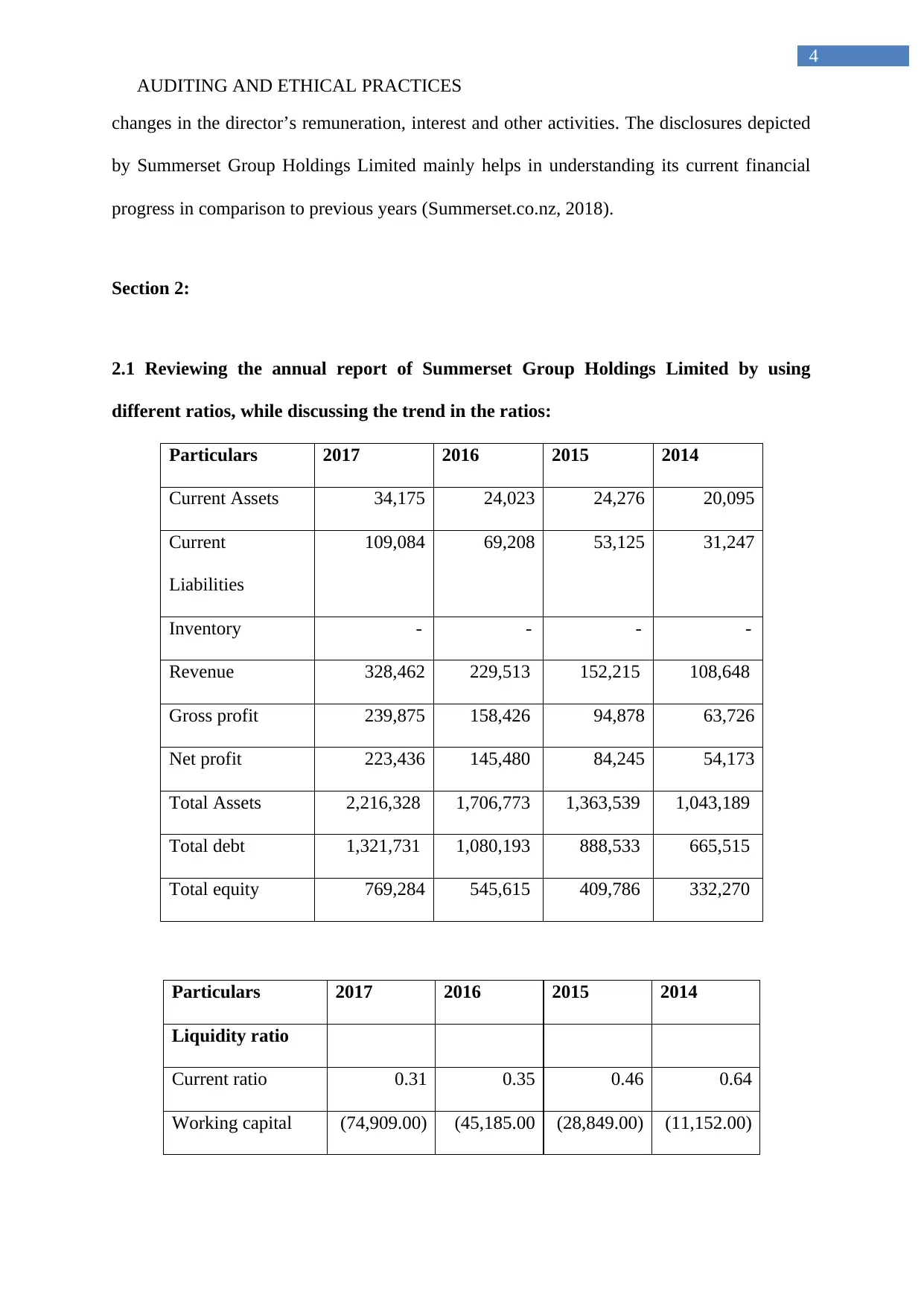
AUDITING AND ETHICAL PRACTICES
4
changes in the director’s remuneration, interest and other activities. The disclosures depicted
by Summerset Group Holdings Limited mainly helps in understanding its current financial
progress in comparison to previous years (Summerset.co.nz, 2018).
Section 2:
2.1 Reviewing the annual report of Summerset Group Holdings Limited by using
different ratios, while discussing the trend in the ratios:
Particulars 2017 2016 2015 2014
Current Assets 34,175 24,023 24,276 20,095
Current
Liabilities
109,084 69,208 53,125 31,247
Inventory - - - -
Revenue 328,462 229,513 152,215 108,648
Gross profit 239,875 158,426 94,878 63,726
Net profit 223,436 145,480 84,245 54,173
Total Assets 2,216,328 1,706,773 1,363,539 1,043,189
Total debt 1,321,731 1,080,193 888,533 665,515
Total equity 769,284 545,615 409,786 332,270
Particulars 2017 2016 2015 2014
Liquidity ratio
Current ratio 0.31 0.35 0.46 0.64
Working capital (74,909.00) (45,185.00 (28,849.00) (11,152.00)
4
changes in the director’s remuneration, interest and other activities. The disclosures depicted
by Summerset Group Holdings Limited mainly helps in understanding its current financial
progress in comparison to previous years (Summerset.co.nz, 2018).
Section 2:
2.1 Reviewing the annual report of Summerset Group Holdings Limited by using
different ratios, while discussing the trend in the ratios:
Particulars 2017 2016 2015 2014
Current Assets 34,175 24,023 24,276 20,095
Current
Liabilities
109,084 69,208 53,125 31,247
Inventory - - - -
Revenue 328,462 229,513 152,215 108,648
Gross profit 239,875 158,426 94,878 63,726
Net profit 223,436 145,480 84,245 54,173
Total Assets 2,216,328 1,706,773 1,363,539 1,043,189
Total debt 1,321,731 1,080,193 888,533 665,515
Total equity 769,284 545,615 409,786 332,270
Particulars 2017 2016 2015 2014
Liquidity ratio
Current ratio 0.31 0.35 0.46 0.64
Working capital (74,909.00) (45,185.00 (28,849.00) (11,152.00)
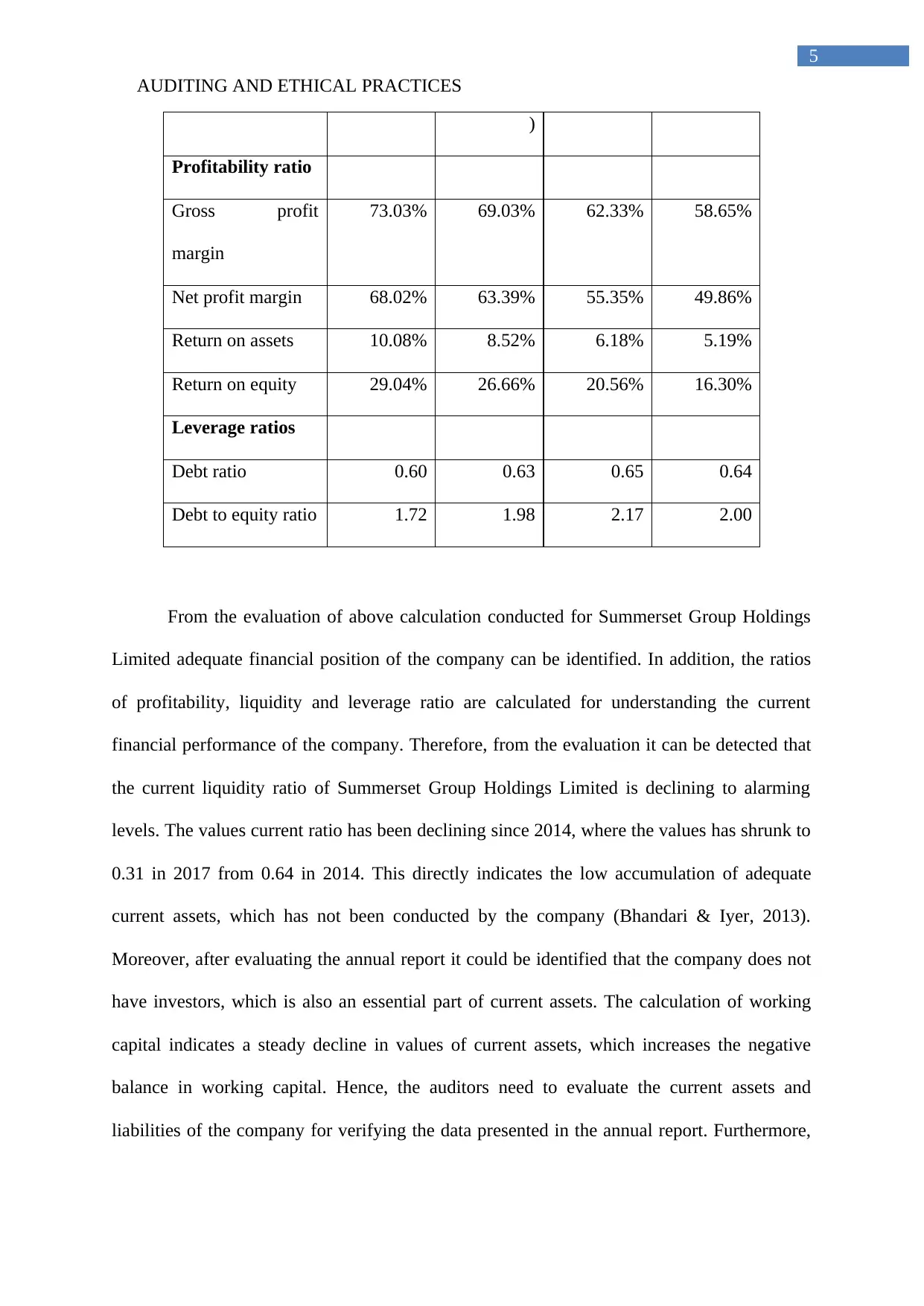
AUDITING AND ETHICAL PRACTICES
5
)
Profitability ratio
Gross profit
margin
73.03% 69.03% 62.33% 58.65%
Net profit margin 68.02% 63.39% 55.35% 49.86%
Return on assets 10.08% 8.52% 6.18% 5.19%
Return on equity 29.04% 26.66% 20.56% 16.30%
Leverage ratios
Debt ratio 0.60 0.63 0.65 0.64
Debt to equity ratio 1.72 1.98 2.17 2.00
From the evaluation of above calculation conducted for Summerset Group Holdings
Limited adequate financial position of the company can be identified. In addition, the ratios
of profitability, liquidity and leverage ratio are calculated for understanding the current
financial performance of the company. Therefore, from the evaluation it can be detected that
the current liquidity ratio of Summerset Group Holdings Limited is declining to alarming
levels. The values current ratio has been declining since 2014, where the values has shrunk to
0.31 in 2017 from 0.64 in 2014. This directly indicates the low accumulation of adequate
current assets, which has not been conducted by the company (Bhandari & Iyer, 2013).
Moreover, after evaluating the annual report it could be identified that the company does not
have investors, which is also an essential part of current assets. The calculation of working
capital indicates a steady decline in values of current assets, which increases the negative
balance in working capital. Hence, the auditors need to evaluate the current assets and
liabilities of the company for verifying the data presented in the annual report. Furthermore,
5
)
Profitability ratio
Gross profit
margin
73.03% 69.03% 62.33% 58.65%
Net profit margin 68.02% 63.39% 55.35% 49.86%
Return on assets 10.08% 8.52% 6.18% 5.19%
Return on equity 29.04% 26.66% 20.56% 16.30%
Leverage ratios
Debt ratio 0.60 0.63 0.65 0.64
Debt to equity ratio 1.72 1.98 2.17 2.00
From the evaluation of above calculation conducted for Summerset Group Holdings
Limited adequate financial position of the company can be identified. In addition, the ratios
of profitability, liquidity and leverage ratio are calculated for understanding the current
financial performance of the company. Therefore, from the evaluation it can be detected that
the current liquidity ratio of Summerset Group Holdings Limited is declining to alarming
levels. The values current ratio has been declining since 2014, where the values has shrunk to
0.31 in 2017 from 0.64 in 2014. This directly indicates the low accumulation of adequate
current assets, which has not been conducted by the company (Bhandari & Iyer, 2013).
Moreover, after evaluating the annual report it could be identified that the company does not
have investors, which is also an essential part of current assets. The calculation of working
capital indicates a steady decline in values of current assets, which increases the negative
balance in working capital. Hence, the auditors need to evaluate the current assets and
liabilities of the company for verifying the data presented in the annual report. Furthermore,
⊘ This is a preview!⊘
Do you want full access?
Subscribe today to unlock all pages.

Trusted by 1+ million students worldwide
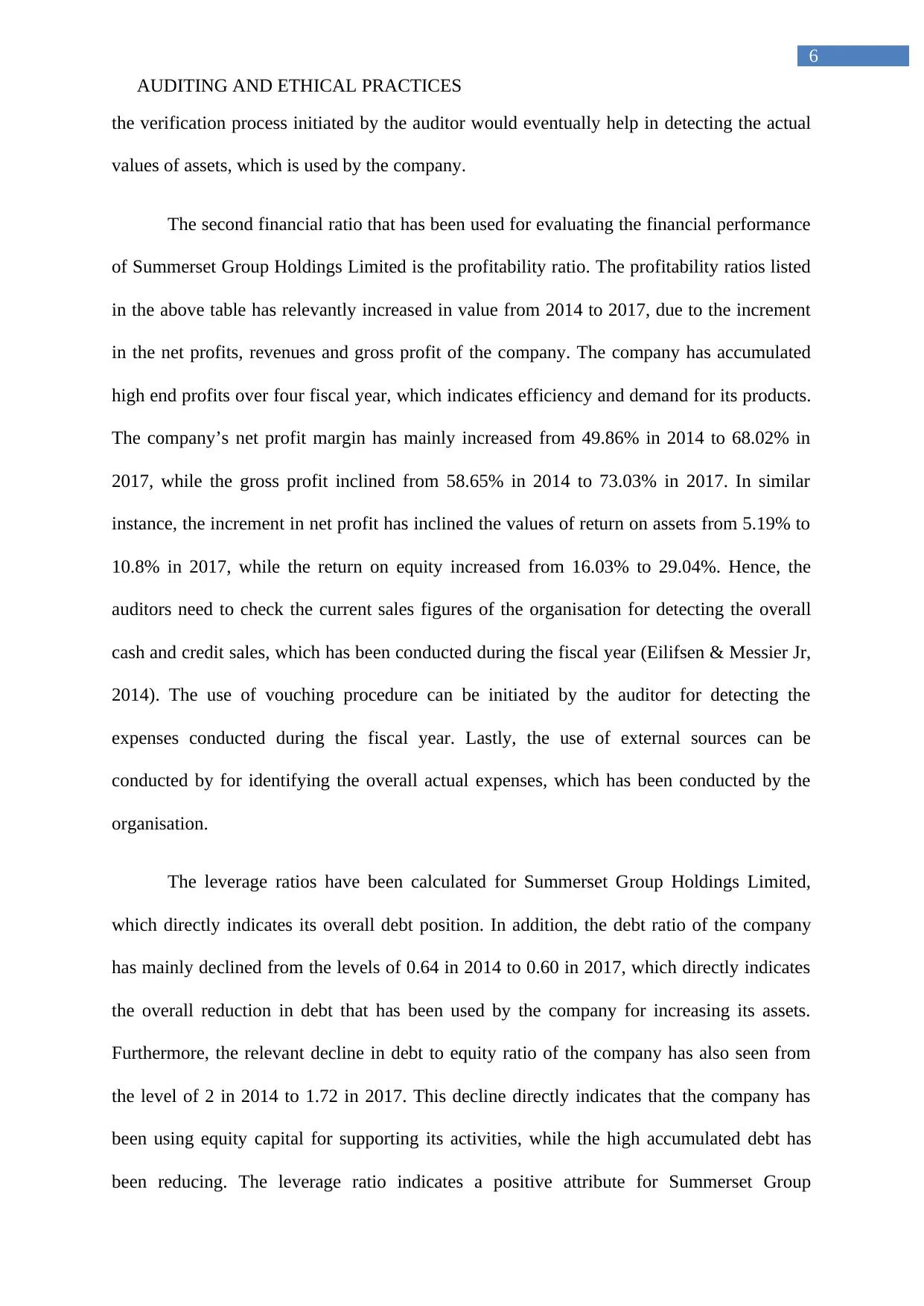
AUDITING AND ETHICAL PRACTICES
6
the verification process initiated by the auditor would eventually help in detecting the actual
values of assets, which is used by the company.
The second financial ratio that has been used for evaluating the financial performance
of Summerset Group Holdings Limited is the profitability ratio. The profitability ratios listed
in the above table has relevantly increased in value from 2014 to 2017, due to the increment
in the net profits, revenues and gross profit of the company. The company has accumulated
high end profits over four fiscal year, which indicates efficiency and demand for its products.
The company’s net profit margin has mainly increased from 49.86% in 2014 to 68.02% in
2017, while the gross profit inclined from 58.65% in 2014 to 73.03% in 2017. In similar
instance, the increment in net profit has inclined the values of return on assets from 5.19% to
10.8% in 2017, while the return on equity increased from 16.03% to 29.04%. Hence, the
auditors need to check the current sales figures of the organisation for detecting the overall
cash and credit sales, which has been conducted during the fiscal year (Eilifsen & Messier Jr,
2014). The use of vouching procedure can be initiated by the auditor for detecting the
expenses conducted during the fiscal year. Lastly, the use of external sources can be
conducted by for identifying the overall actual expenses, which has been conducted by the
organisation.
The leverage ratios have been calculated for Summerset Group Holdings Limited,
which directly indicates its overall debt position. In addition, the debt ratio of the company
has mainly declined from the levels of 0.64 in 2014 to 0.60 in 2017, which directly indicates
the overall reduction in debt that has been used by the company for increasing its assets.
Furthermore, the relevant decline in debt to equity ratio of the company has also seen from
the level of 2 in 2014 to 1.72 in 2017. This decline directly indicates that the company has
been using equity capital for supporting its activities, while the high accumulated debt has
been reducing. The leverage ratio indicates a positive attribute for Summerset Group
6
the verification process initiated by the auditor would eventually help in detecting the actual
values of assets, which is used by the company.
The second financial ratio that has been used for evaluating the financial performance
of Summerset Group Holdings Limited is the profitability ratio. The profitability ratios listed
in the above table has relevantly increased in value from 2014 to 2017, due to the increment
in the net profits, revenues and gross profit of the company. The company has accumulated
high end profits over four fiscal year, which indicates efficiency and demand for its products.
The company’s net profit margin has mainly increased from 49.86% in 2014 to 68.02% in
2017, while the gross profit inclined from 58.65% in 2014 to 73.03% in 2017. In similar
instance, the increment in net profit has inclined the values of return on assets from 5.19% to
10.8% in 2017, while the return on equity increased from 16.03% to 29.04%. Hence, the
auditors need to check the current sales figures of the organisation for detecting the overall
cash and credit sales, which has been conducted during the fiscal year (Eilifsen & Messier Jr,
2014). The use of vouching procedure can be initiated by the auditor for detecting the
expenses conducted during the fiscal year. Lastly, the use of external sources can be
conducted by for identifying the overall actual expenses, which has been conducted by the
organisation.
The leverage ratios have been calculated for Summerset Group Holdings Limited,
which directly indicates its overall debt position. In addition, the debt ratio of the company
has mainly declined from the levels of 0.64 in 2014 to 0.60 in 2017, which directly indicates
the overall reduction in debt that has been used by the company for increasing its assets.
Furthermore, the relevant decline in debt to equity ratio of the company has also seen from
the level of 2 in 2014 to 1.72 in 2017. This decline directly indicates that the company has
been using equity capital for supporting its activities, while the high accumulated debt has
been reducing. The leverage ratio indicates a positive attribute for Summerset Group
Paraphrase This Document
Need a fresh take? Get an instant paraphrase of this document with our AI Paraphraser
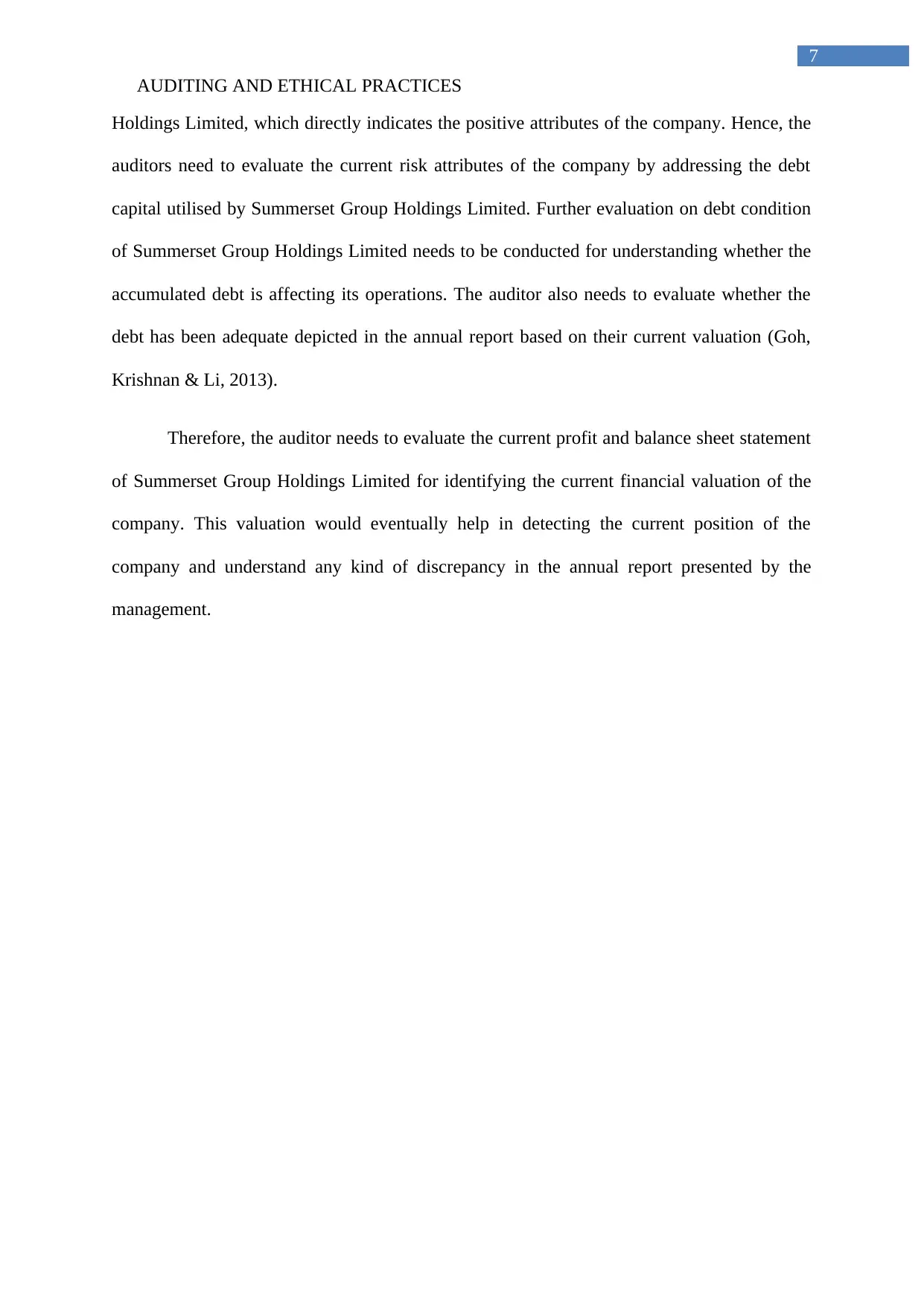
AUDITING AND ETHICAL PRACTICES
7
Holdings Limited, which directly indicates the positive attributes of the company. Hence, the
auditors need to evaluate the current risk attributes of the company by addressing the debt
capital utilised by Summerset Group Holdings Limited. Further evaluation on debt condition
of Summerset Group Holdings Limited needs to be conducted for understanding whether the
accumulated debt is affecting its operations. The auditor also needs to evaluate whether the
debt has been adequate depicted in the annual report based on their current valuation (Goh,
Krishnan & Li, 2013).
Therefore, the auditor needs to evaluate the current profit and balance sheet statement
of Summerset Group Holdings Limited for identifying the current financial valuation of the
company. This valuation would eventually help in detecting the current position of the
company and understand any kind of discrepancy in the annual report presented by the
management.
7
Holdings Limited, which directly indicates the positive attributes of the company. Hence, the
auditors need to evaluate the current risk attributes of the company by addressing the debt
capital utilised by Summerset Group Holdings Limited. Further evaluation on debt condition
of Summerset Group Holdings Limited needs to be conducted for understanding whether the
accumulated debt is affecting its operations. The auditor also needs to evaluate whether the
debt has been adequate depicted in the annual report based on their current valuation (Goh,
Krishnan & Li, 2013).
Therefore, the auditor needs to evaluate the current profit and balance sheet statement
of Summerset Group Holdings Limited for identifying the current financial valuation of the
company. This valuation would eventually help in detecting the current position of the
company and understand any kind of discrepancy in the annual report presented by the
management.
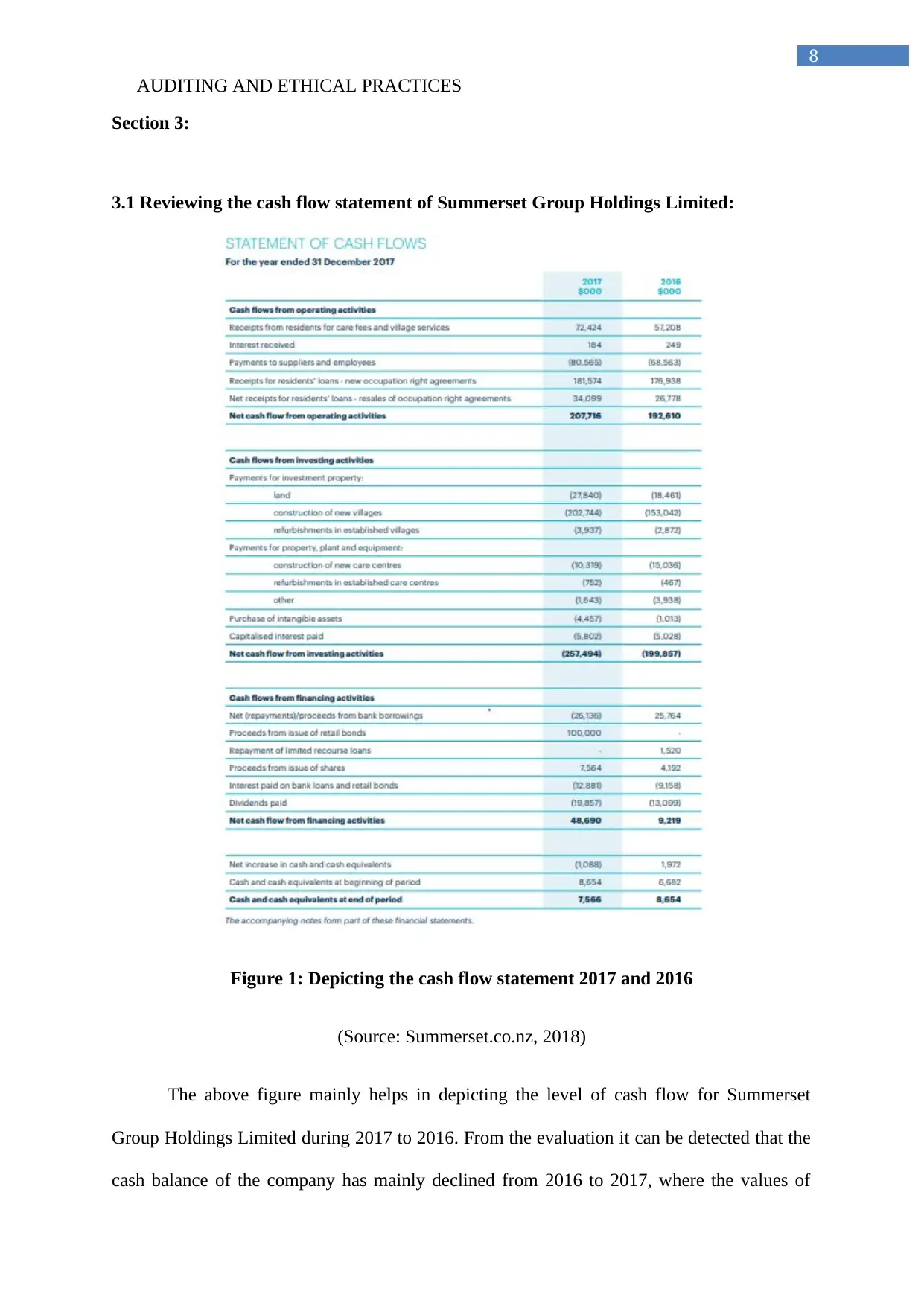
AUDITING AND ETHICAL PRACTICES
8
Section 3:
3.1 Reviewing the cash flow statement of Summerset Group Holdings Limited:
Figure 1: Depicting the cash flow statement 2017 and 2016
(Source: Summerset.co.nz, 2018)
The above figure mainly helps in depicting the level of cash flow for Summerset
Group Holdings Limited during 2017 to 2016. From the evaluation it can be detected that the
cash balance of the company has mainly declined from 2016 to 2017, where the values of
8
Section 3:
3.1 Reviewing the cash flow statement of Summerset Group Holdings Limited:
Figure 1: Depicting the cash flow statement 2017 and 2016
(Source: Summerset.co.nz, 2018)
The above figure mainly helps in depicting the level of cash flow for Summerset
Group Holdings Limited during 2017 to 2016. From the evaluation it can be detected that the
cash balance of the company has mainly declined from 2016 to 2017, where the values of
⊘ This is a preview!⊘
Do you want full access?
Subscribe today to unlock all pages.

Trusted by 1+ million students worldwide
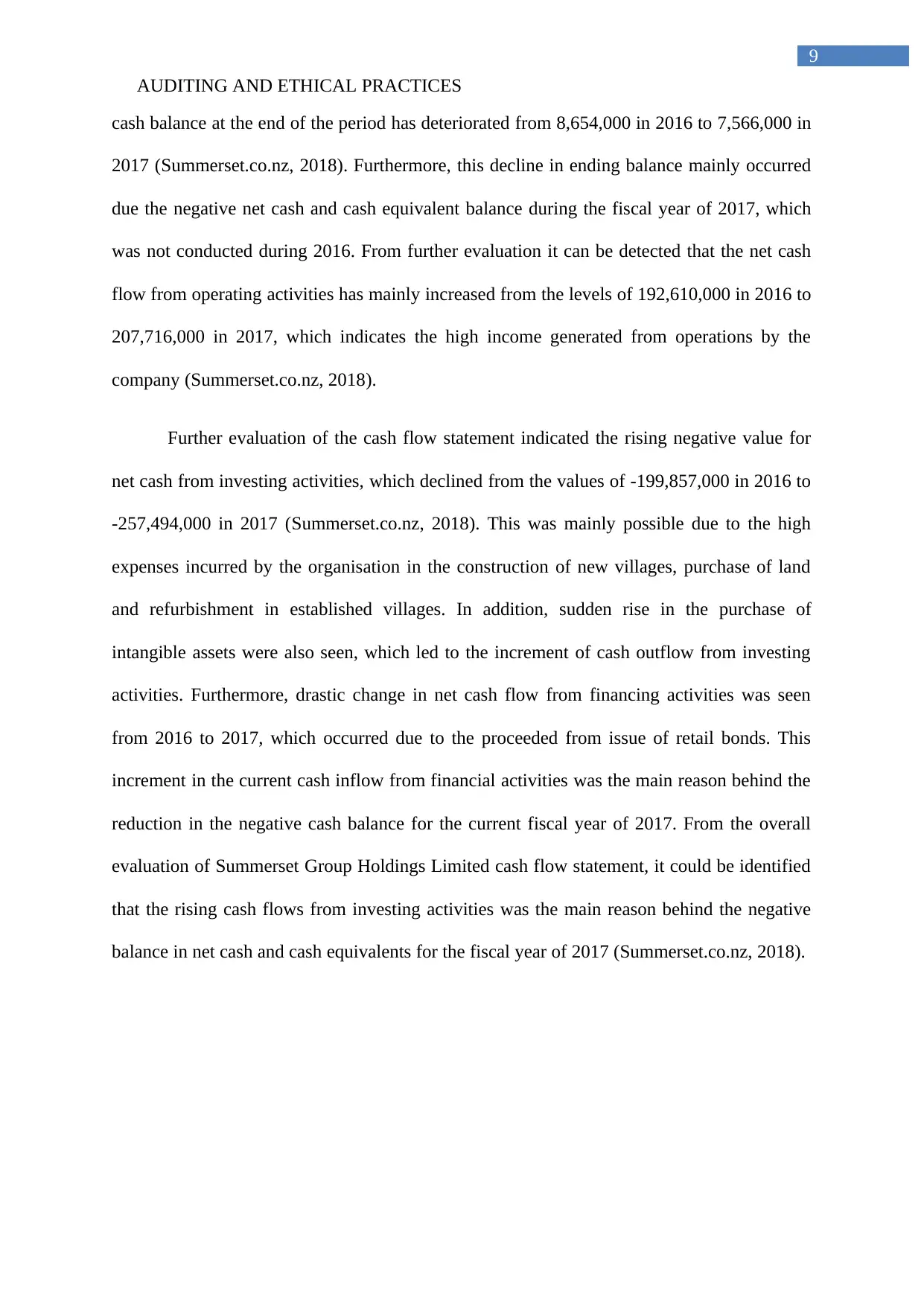
AUDITING AND ETHICAL PRACTICES
9
cash balance at the end of the period has deteriorated from 8,654,000 in 2016 to 7,566,000 in
2017 (Summerset.co.nz, 2018). Furthermore, this decline in ending balance mainly occurred
due the negative net cash and cash equivalent balance during the fiscal year of 2017, which
was not conducted during 2016. From further evaluation it can be detected that the net cash
flow from operating activities has mainly increased from the levels of 192,610,000 in 2016 to
207,716,000 in 2017, which indicates the high income generated from operations by the
company (Summerset.co.nz, 2018).
Further evaluation of the cash flow statement indicated the rising negative value for
net cash from investing activities, which declined from the values of -199,857,000 in 2016 to
-257,494,000 in 2017 (Summerset.co.nz, 2018). This was mainly possible due to the high
expenses incurred by the organisation in the construction of new villages, purchase of land
and refurbishment in established villages. In addition, sudden rise in the purchase of
intangible assets were also seen, which led to the increment of cash outflow from investing
activities. Furthermore, drastic change in net cash flow from financing activities was seen
from 2016 to 2017, which occurred due to the proceeded from issue of retail bonds. This
increment in the current cash inflow from financial activities was the main reason behind the
reduction in the negative cash balance for the current fiscal year of 2017. From the overall
evaluation of Summerset Group Holdings Limited cash flow statement, it could be identified
that the rising cash flows from investing activities was the main reason behind the negative
balance in net cash and cash equivalents for the fiscal year of 2017 (Summerset.co.nz, 2018).
9
cash balance at the end of the period has deteriorated from 8,654,000 in 2016 to 7,566,000 in
2017 (Summerset.co.nz, 2018). Furthermore, this decline in ending balance mainly occurred
due the negative net cash and cash equivalent balance during the fiscal year of 2017, which
was not conducted during 2016. From further evaluation it can be detected that the net cash
flow from operating activities has mainly increased from the levels of 192,610,000 in 2016 to
207,716,000 in 2017, which indicates the high income generated from operations by the
company (Summerset.co.nz, 2018).
Further evaluation of the cash flow statement indicated the rising negative value for
net cash from investing activities, which declined from the values of -199,857,000 in 2016 to
-257,494,000 in 2017 (Summerset.co.nz, 2018). This was mainly possible due to the high
expenses incurred by the organisation in the construction of new villages, purchase of land
and refurbishment in established villages. In addition, sudden rise in the purchase of
intangible assets were also seen, which led to the increment of cash outflow from investing
activities. Furthermore, drastic change in net cash flow from financing activities was seen
from 2016 to 2017, which occurred due to the proceeded from issue of retail bonds. This
increment in the current cash inflow from financial activities was the main reason behind the
reduction in the negative cash balance for the current fiscal year of 2017. From the overall
evaluation of Summerset Group Holdings Limited cash flow statement, it could be identified
that the rising cash flows from investing activities was the main reason behind the negative
balance in net cash and cash equivalents for the fiscal year of 2017 (Summerset.co.nz, 2018).
Paraphrase This Document
Need a fresh take? Get an instant paraphrase of this document with our AI Paraphraser
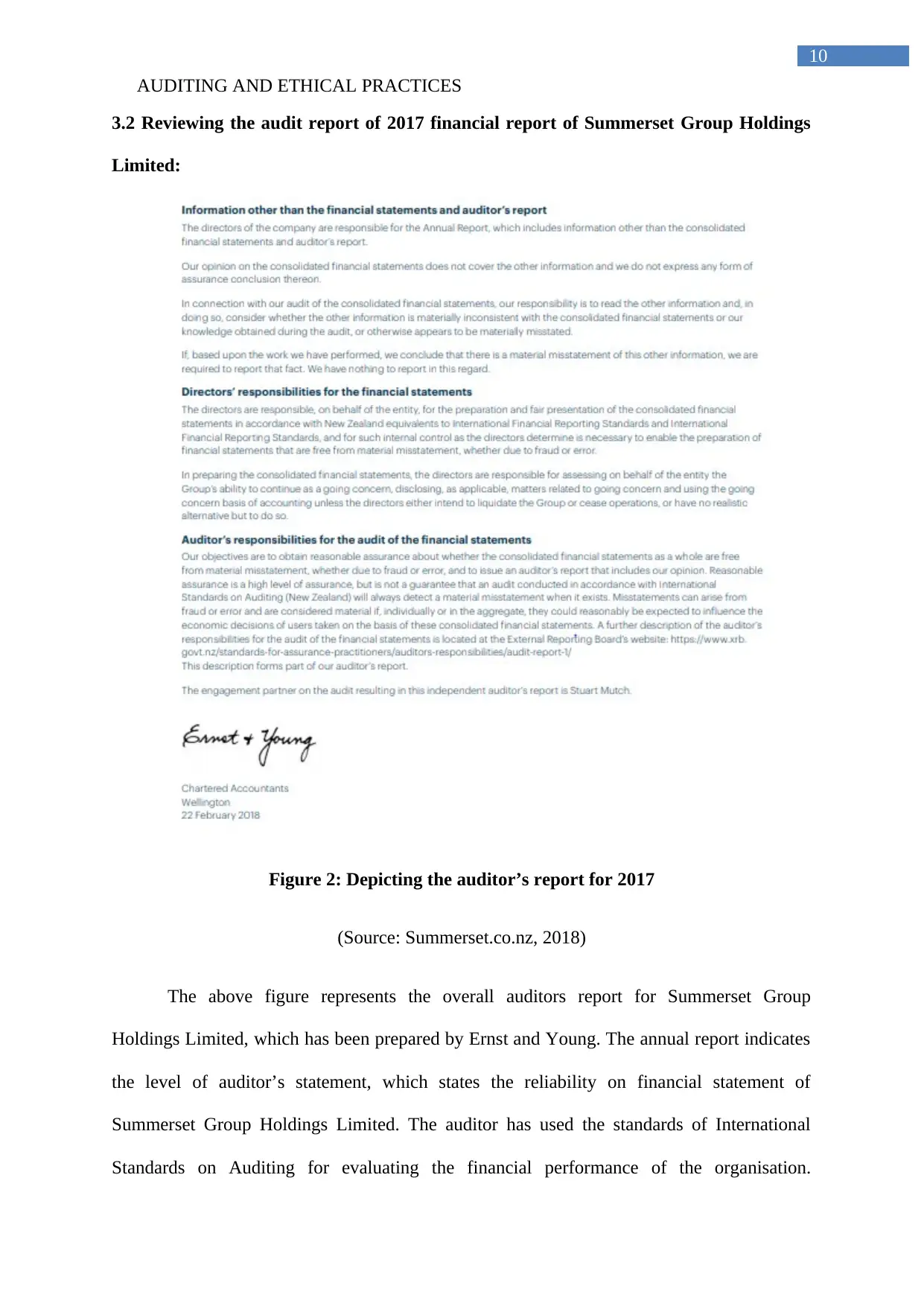
AUDITING AND ETHICAL PRACTICES
10
3.2 Reviewing the audit report of 2017 financial report of Summerset Group Holdings
Limited:
Figure 2: Depicting the auditor’s report for 2017
(Source: Summerset.co.nz, 2018)
The above figure represents the overall auditors report for Summerset Group
Holdings Limited, which has been prepared by Ernst and Young. The annual report indicates
the level of auditor’s statement, which states the reliability on financial statement of
Summerset Group Holdings Limited. The auditor has used the standards of International
Standards on Auditing for evaluating the financial performance of the organisation.
10
3.2 Reviewing the audit report of 2017 financial report of Summerset Group Holdings
Limited:
Figure 2: Depicting the auditor’s report for 2017
(Source: Summerset.co.nz, 2018)
The above figure represents the overall auditors report for Summerset Group
Holdings Limited, which has been prepared by Ernst and Young. The annual report indicates
the level of auditor’s statement, which states the reliability on financial statement of
Summerset Group Holdings Limited. The auditor has used the standards of International
Standards on Auditing for evaluating the financial performance of the organisation.
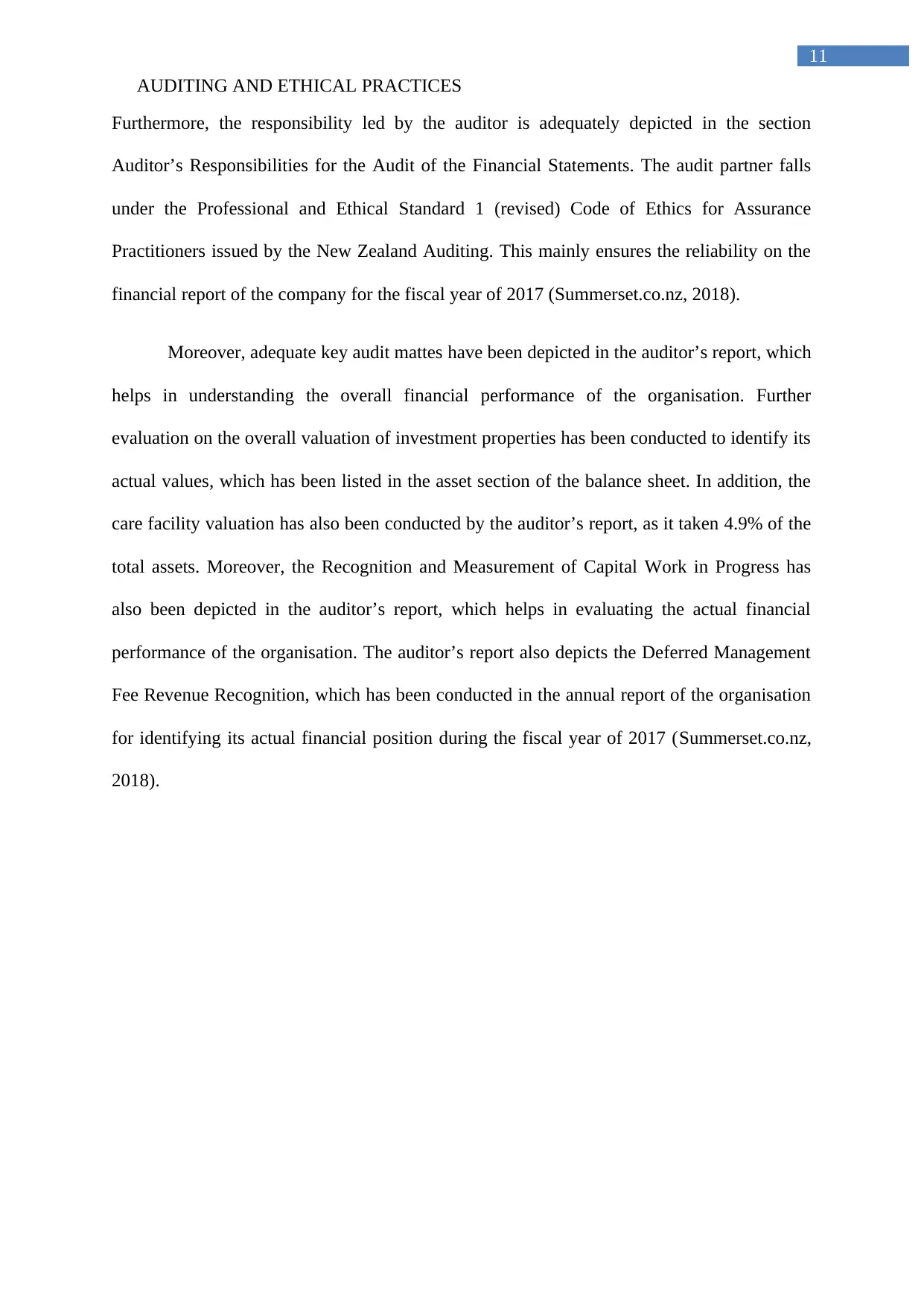
AUDITING AND ETHICAL PRACTICES
11
Furthermore, the responsibility led by the auditor is adequately depicted in the section
Auditor’s Responsibilities for the Audit of the Financial Statements. The audit partner falls
under the Professional and Ethical Standard 1 (revised) Code of Ethics for Assurance
Practitioners issued by the New Zealand Auditing. This mainly ensures the reliability on the
financial report of the company for the fiscal year of 2017 (Summerset.co.nz, 2018).
Moreover, adequate key audit mattes have been depicted in the auditor’s report, which
helps in understanding the overall financial performance of the organisation. Further
evaluation on the overall valuation of investment properties has been conducted to identify its
actual values, which has been listed in the asset section of the balance sheet. In addition, the
care facility valuation has also been conducted by the auditor’s report, as it taken 4.9% of the
total assets. Moreover, the Recognition and Measurement of Capital Work in Progress has
also been depicted in the auditor’s report, which helps in evaluating the actual financial
performance of the organisation. The auditor’s report also depicts the Deferred Management
Fee Revenue Recognition, which has been conducted in the annual report of the organisation
for identifying its actual financial position during the fiscal year of 2017 (Summerset.co.nz,
2018).
11
Furthermore, the responsibility led by the auditor is adequately depicted in the section
Auditor’s Responsibilities for the Audit of the Financial Statements. The audit partner falls
under the Professional and Ethical Standard 1 (revised) Code of Ethics for Assurance
Practitioners issued by the New Zealand Auditing. This mainly ensures the reliability on the
financial report of the company for the fiscal year of 2017 (Summerset.co.nz, 2018).
Moreover, adequate key audit mattes have been depicted in the auditor’s report, which
helps in understanding the overall financial performance of the organisation. Further
evaluation on the overall valuation of investment properties has been conducted to identify its
actual values, which has been listed in the asset section of the balance sheet. In addition, the
care facility valuation has also been conducted by the auditor’s report, as it taken 4.9% of the
total assets. Moreover, the Recognition and Measurement of Capital Work in Progress has
also been depicted in the auditor’s report, which helps in evaluating the actual financial
performance of the organisation. The auditor’s report also depicts the Deferred Management
Fee Revenue Recognition, which has been conducted in the annual report of the organisation
for identifying its actual financial position during the fiscal year of 2017 (Summerset.co.nz,
2018).
⊘ This is a preview!⊘
Do you want full access?
Subscribe today to unlock all pages.

Trusted by 1+ million students worldwide

AUDITING AND ETHICAL PRACTICES
12
References and Bibliography:
Asx.com.au. (2018). Asx.com.au. Retrieved 2 September 2018, from
https://www.asx.com.au/asx/share-price-research/company/SNZ
Bhandari, S. B., & Iyer, R. (2013). Predicting business failure using cash flow statement
based measures. Managerial Finance, 39(7), 667-676.
Byrnes, A., Banks, M., Mudge, A., Young, A., & Bauer, J. (2018). Enhanced Recovery After
Surgery as an auditing framework for identifying improvements to perioperative
nutrition care of older surgical patients. European journal of clinical nutrition, 72(6),
913.
Eilifsen, A., & Messier Jr, W. F. (2014). Materiality guidance of the major public accounting
firms. Auditing: A Journal of Practice & Theory, 34(2), 3-26.
El-Kassar, A. N., Messarra, L., & Elgammal, W. (2015). Effects of ethical practices on
corporate governance in developing countries: evidence from Lebanon and
Egypt. Corporate Ownership and Control, 12(3), 494-504.
Espinosa-Pike, M., & Barrainkua, I. (2016). An exploratory study of the pressures and ethical
dilemmas in the audit conflict. Revista de Contabilidad, 19(1), 10-20.
Ferrell, O. C., & Fraedrich, J. (2015). Business ethics: Ethical decision making & cases.
Nelson Education.
Goh, B. W., Krishnan, J., & Li, D. (2013). Auditor reporting under Section 404: The
association between the internal control and going concern audit opinions. Contemporary
Accounting Research, 30(3), 970-995.
12
References and Bibliography:
Asx.com.au. (2018). Asx.com.au. Retrieved 2 September 2018, from
https://www.asx.com.au/asx/share-price-research/company/SNZ
Bhandari, S. B., & Iyer, R. (2013). Predicting business failure using cash flow statement
based measures. Managerial Finance, 39(7), 667-676.
Byrnes, A., Banks, M., Mudge, A., Young, A., & Bauer, J. (2018). Enhanced Recovery After
Surgery as an auditing framework for identifying improvements to perioperative
nutrition care of older surgical patients. European journal of clinical nutrition, 72(6),
913.
Eilifsen, A., & Messier Jr, W. F. (2014). Materiality guidance of the major public accounting
firms. Auditing: A Journal of Practice & Theory, 34(2), 3-26.
El-Kassar, A. N., Messarra, L., & Elgammal, W. (2015). Effects of ethical practices on
corporate governance in developing countries: evidence from Lebanon and
Egypt. Corporate Ownership and Control, 12(3), 494-504.
Espinosa-Pike, M., & Barrainkua, I. (2016). An exploratory study of the pressures and ethical
dilemmas in the audit conflict. Revista de Contabilidad, 19(1), 10-20.
Ferrell, O. C., & Fraedrich, J. (2015). Business ethics: Ethical decision making & cases.
Nelson Education.
Goh, B. W., Krishnan, J., & Li, D. (2013). Auditor reporting under Section 404: The
association between the internal control and going concern audit opinions. Contemporary
Accounting Research, 30(3), 970-995.
Paraphrase This Document
Need a fresh take? Get an instant paraphrase of this document with our AI Paraphraser
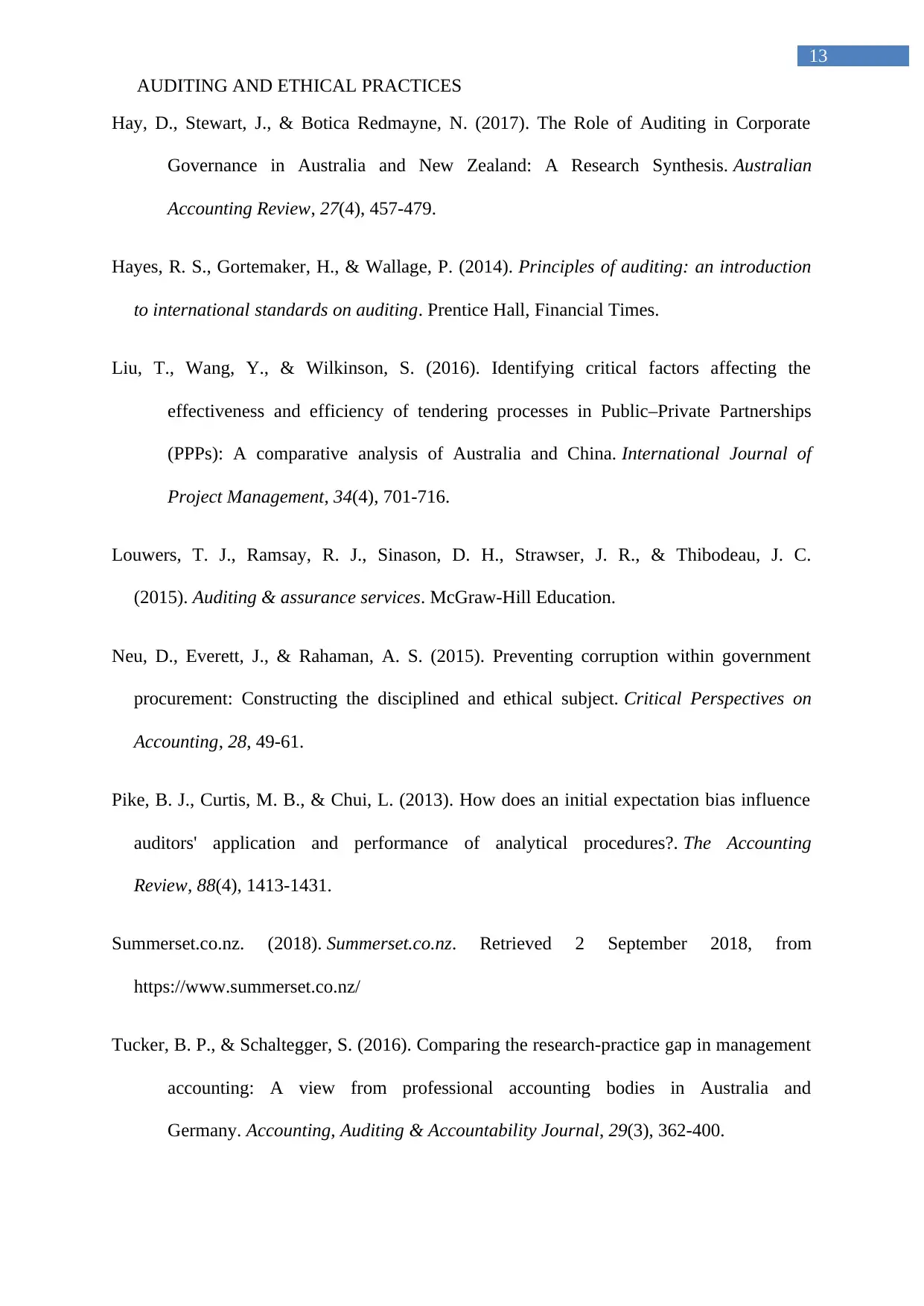
AUDITING AND ETHICAL PRACTICES
13
Hay, D., Stewart, J., & Botica Redmayne, N. (2017). The Role of Auditing in Corporate
Governance in Australia and New Zealand: A Research Synthesis. Australian
Accounting Review, 27(4), 457-479.
Hayes, R. S., Gortemaker, H., & Wallage, P. (2014). Principles of auditing: an introduction
to international standards on auditing. Prentice Hall, Financial Times.
Liu, T., Wang, Y., & Wilkinson, S. (2016). Identifying critical factors affecting the
effectiveness and efficiency of tendering processes in Public–Private Partnerships
(PPPs): A comparative analysis of Australia and China. International Journal of
Project Management, 34(4), 701-716.
Louwers, T. J., Ramsay, R. J., Sinason, D. H., Strawser, J. R., & Thibodeau, J. C.
(2015). Auditing & assurance services. McGraw-Hill Education.
Neu, D., Everett, J., & Rahaman, A. S. (2015). Preventing corruption within government
procurement: Constructing the disciplined and ethical subject. Critical Perspectives on
Accounting, 28, 49-61.
Pike, B. J., Curtis, M. B., & Chui, L. (2013). How does an initial expectation bias influence
auditors' application and performance of analytical procedures?. The Accounting
Review, 88(4), 1413-1431.
Summerset.co.nz. (2018). Summerset.co.nz. Retrieved 2 September 2018, from
https://www.summerset.co.nz/
Tucker, B. P., & Schaltegger, S. (2016). Comparing the research-practice gap in management
accounting: A view from professional accounting bodies in Australia and
Germany. Accounting, Auditing & Accountability Journal, 29(3), 362-400.
13
Hay, D., Stewart, J., & Botica Redmayne, N. (2017). The Role of Auditing in Corporate
Governance in Australia and New Zealand: A Research Synthesis. Australian
Accounting Review, 27(4), 457-479.
Hayes, R. S., Gortemaker, H., & Wallage, P. (2014). Principles of auditing: an introduction
to international standards on auditing. Prentice Hall, Financial Times.
Liu, T., Wang, Y., & Wilkinson, S. (2016). Identifying critical factors affecting the
effectiveness and efficiency of tendering processes in Public–Private Partnerships
(PPPs): A comparative analysis of Australia and China. International Journal of
Project Management, 34(4), 701-716.
Louwers, T. J., Ramsay, R. J., Sinason, D. H., Strawser, J. R., & Thibodeau, J. C.
(2015). Auditing & assurance services. McGraw-Hill Education.
Neu, D., Everett, J., & Rahaman, A. S. (2015). Preventing corruption within government
procurement: Constructing the disciplined and ethical subject. Critical Perspectives on
Accounting, 28, 49-61.
Pike, B. J., Curtis, M. B., & Chui, L. (2013). How does an initial expectation bias influence
auditors' application and performance of analytical procedures?. The Accounting
Review, 88(4), 1413-1431.
Summerset.co.nz. (2018). Summerset.co.nz. Retrieved 2 September 2018, from
https://www.summerset.co.nz/
Tucker, B. P., & Schaltegger, S. (2016). Comparing the research-practice gap in management
accounting: A view from professional accounting bodies in Australia and
Germany. Accounting, Auditing & Accountability Journal, 29(3), 362-400.
1 out of 14
Related Documents
Your All-in-One AI-Powered Toolkit for Academic Success.
+13062052269
info@desklib.com
Available 24*7 on WhatsApp / Email
![[object Object]](/_next/static/media/star-bottom.7253800d.svg)
Unlock your academic potential
© 2024 | Zucol Services PVT LTD | All rights reserved.





